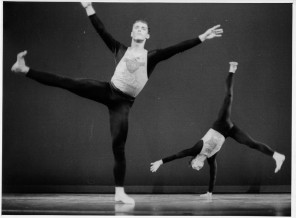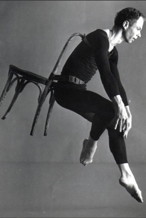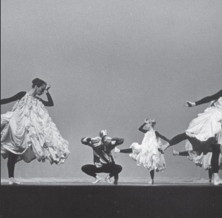8-14 Sept 1964(Edit)
Five New York Evenings / Fem New Yorkkvällar
Description :(Edit)
In the fall of 1964, Merce Cunningham was doing a world tour with his 'Dance Company" and Moderna Museet invited him to come to Stockholm for a holiday but also to do something at the museum. While the New Yorkers, who included Rauschenberg, Steve Paxton, John Cage, David Tudor, Caroline Brown, Alex Hay, Debora Hay, Robert Morris, Yvonne Rainer, and Trisha Brown, spent their vacation at Ultveld's country house just outside Stockholm, a so called "happening' was organized and held at the museum titled "5 New York Evenings". — (Lars Patrik Andersson, "Hon-En Katedral, The Mechanical Bride Stripped in Stockholm, Even", Thesis, University of British Columbia, Sept 1993)
Source : https://circle.ubc.ca/bitstream/handle/2429/2714/ubc_1993_fall_anderssson_lars_patrik.PDF?sequence=1
In 1964, the Moderna Museet and Fylkingen jointly organised five New York evenings with ballet, concerts and happenings. Stockholm was visited by the Merce Cunningham Dance Company with John Cage, David Tudor, Yvonne Rainer, Robert Morris and Robert Rauschenberg. Rauschenberg accompanied Cunningham’s company on a world tour, designing costumes, lighting and stage sets. — (Anna Tellgren)
Source : http://www.modernamuseet.se/en/Stockholm/Exhibitions/2007/Robert-Rauschenberg-Combines/Biography/Robert-Rauschenberg-and-Moderna-Museet/
During the five evenings the most recent performative work of the Manhattan neo-avant-garde was introduced to the Swedish audience. John Cage and David Tudor, Merce Cunningham and his company, Robert Rauschenberg and Steve Paxton as well as the Swedish artist residing in Manhattan, Öyvind Fahlström, performed.
The living cow included in Rauschenberg’s performance has since become the icon of the program and the avant-garde aura of the museum. One of the evenings that have been payed less attention to however, Friday September 11th, was devoted to Yvonne Rainer and her partner Robert Morris’ "An Evening of Talking and Dancing". It relied on simple body movements, the human voice, everyday sound as well as composed music. The structure of the performance leaned on the basical understanding of the interaction between body and the object.
Artists :(Edit)
Evening 1 (September 8, 1964 - Moderna Museet) |
- Merce Cunningham and his dance company : Museum Event # 2
- Performed with David Tudor : John Cage — Atlas Eclipticalis (percussion part)
- Merce Cunningham’s Museum Event No.1, No. 2, and No. 3, which he created for museums in Vienna and Stockholm. Cunningham was invited to perform dances from his repertoire in those museums, but adjustments were necessary. The unconventional nature of these venues led him not only to resequence segments of the dance pieces, but also required him to use different music. Each performance lasted only between eighty and ninety minutes without an intermission. Cunningham was so satisfied with his Museum Events that whenever he performed in non-theatrical spaces he used this compositional format, which became known as “Events.” — (Reina Potaznik, "Unusual Dance Spaces", 2007)
- Sources :
http://cagecomp.home.xs4all.nl/1912-1971.htm
http://academiccommons.columbia.edu/catalog/ac:129986
Evening 2 (September 9, 1964 - Moderna Museet) (September 9, 1964 - Opera) |
- Merce Cunningham and his dance company : Antic Meet (1958)
- John Cage — Concert for Piano and Orchestra
- Source : http://cagecomp.home.xs4all.nl/1912-1971.htm
http://www.calperfs.berkeley.edu/learn/program_notes/2010/pn_mcdc.pdf
- Merce Cunningham and his dance company : Crises (1960)
- Conlon Nancarrow — Rhythm Studies (tape)
- Source : http://cagecomp.home.xs4all.nl/1912-1971.htm
- Merce Cunningham and his dance company : Night Wandering (1964)
- Bo Nilsson — Rörelser, Slagfigurer, Kvantiteter (David Tudor, piano)
- duet with Carolyn Brown and Cunningham (where they wore tunics made of animal skins and moved like a pair of big cats), which he made quickly in Sweden, was a tribute to Sweden's premier filmmaker and theater director, Ingmar Bergman.
- Sources :
http://cagecomp.home.xs4all.nl/1912-1971.htm
http://chronicle.com/blogs/brainstorm/from-the-archives-aloff-on-cunningham/7475
http://www.mercecunningham.org/film-media/media-detail/params/mediaID/72/
- Royal Swedish Ballet with guest appearance by Merce Cunningham and Dance Company: Winterbranch (1964) (September 9, Opera)
- La Monte Young — Two Sounds
- → [Read More on Two Sounds]
- Winterbranch infuriated the audience with aggressively loud sound, and lighting that jolted from glare to obscurity, and dancers in black who fell and rolled on the floor and vanished in the gloom. (Marcia B. Siegel )
- Sources :
http://cagecomp.home.xs4all.nl/1912-1971.htm
http://hudsonreview.com/2013/03/prince-of-lightness-merce-cunningham-1919-2009-2/#.UntzuoVGw4A
 "Crises" (1960) | 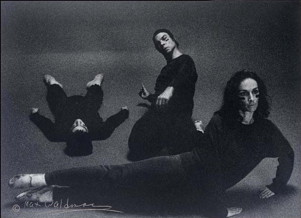 "Winterbranch" (1964) Photo by Max Waldman |  Merce Cunningham’s 1964 Winterbranch. Carolyn Brown (L) and Cunningham. Photo: James Klosty (1971) |
(September 10, 1964 - Moderna Museet) |
- Concert performed with David Tudor
- John Cage — first performance of Electronic Music for Piano (Tudor alone or with Cage?)
- and music by Sylvano Bussotti, Toshi Ichiyanagi, and Christian Wolff
- Source : http://cagecomp.home.xs4all.nl/1912-1971.htm
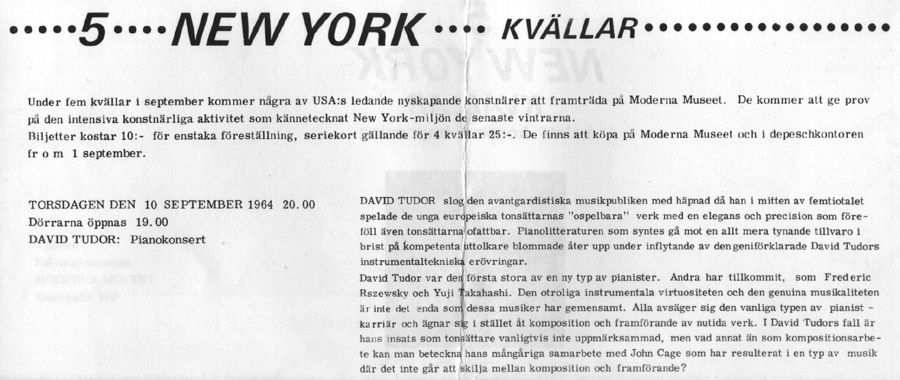 Source : http://davidtudor.org/Graphics/MMprog1.jpg |
Evening 3 (September 11, 1964) Source : http://www.diva-portal.org/smash/get/diva2:388055/FULLTEXT02 |
- Yvonne Rainer At my body’s house (1963).
- This was a solo piece, where Rainer used transmission engineered by Billy Klûver to amplify her breathing via a contact microphone taped to her throat. The dance began with her standing still for three minutes while Buxtehude organ music was played very loudly. This was followed by small, rapid footwork. At one point Rainer told a story about an elephant from the Diary of William Bentley. She had asked Öyvind Fahlström to translate it into Swedish which she had memorized phonetically so that the expression became what she would later term archaic (Rainer 2006).
- Yvonne Rainer, Three Seascapes / Poem for Tables, Chairs and Benches.
- In the first part of the piece Rainer was running around the periphery of the space in a black overcoat accompanied by the last sequences of Sergej Rachmaninoff’s "Second Piano Concerto". In the next part, she was moving with slow-motion undulations on an upstage-to-downstage diagonal, during La Monte Young’s composition "Poem of Tables, Chairs, Benches" → [Read More on Poem by La Monte Young].
- Robert Morris, Site (1963)
- A variation on Edouard Manets painting "Olympia", this was a manifestation of gender juxtaposition and loss of connection. Morris performed in a skin-colored mask that presented his own face. As he danced, he moved large, white pieces of plywood that had formed a space on the stage. Behind them a nude woman was lying perfectly still, as in a tableau vivant of Manet’s painting. The soundscape consisted of the noise of traffic from the street and of workers using drilling machines. The woman was covered with paint and motionless throughout the performance, while the man manipulated large wooden boards, lifted them, caressed them and balanced them on his back as he moved across the stage and stacked them elsewhere. No contact took place between the motionless woman and the hardworking man, neither eye contact nor interaction of movement.
- a performance by Robert Morris with Carolee Schneemann at Stage 73, Surplus Dance Theater, New York, 1964. It was show twice there, on March 2 and 9. Later it was performed again, but without Carolee Schneemann (Olga Adorno Klüver replaced her) at the Institute of Contemporary Art in Philadelphia on April 24, 1964. The last performance of "Site" was on April 29 the same year, this time with Carolee Schneemann again, at the Judson Memorial Church, as part of the Judson Dance Theater's series Concert #16.
- Source : http://artforum.com/video/id=31196&mode=large
- Yvonne Rainer, Some thoughts on improvisation
- "Some thoughts on improvisation" by Rainer was a improvised solo with a spool of white thread, accompanied by a taped reading of an essay by Rainer written after dancing at the Green Gallery during an event by the artist James Lee Byars. In the essay she stated: Improvisation, in my way of handling it, demands a constant connection with some thing - object, action, and/or mood - in a situation. The more connections are established the easier it is to proceed.
- Robert Morris, Check.
- The space was full of people and seemingly random actions were going on in the periphery of the room. As opposed to the distance between audience and dancers in the previous pieces, the central feature of "Check" was the exploration of the interzone between performers and audience.
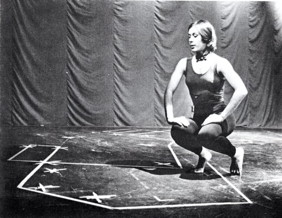 Yvonne Rainer, "At My Body’s House" (1963) | 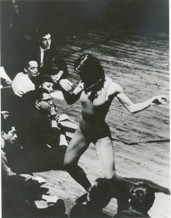 Photo of Yvonne Rainer in Three Seascapes (1963) by Al Giese, Courtesy Bennington College Judson Project. |
Sources :
http://www.fondation-langlois.org/html/f/media.php?NumObjet=70230
http://www.dancemagazine.com/issues/July-2012/50-Years-of-John-Cages-ArtAsLife-Philosophy
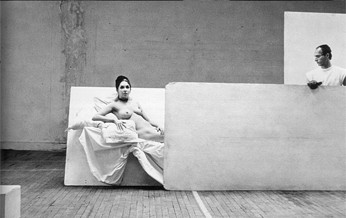 Robert Morris and Carolee Schneemann rehearsing "Site". Photo by Hans Namuth | 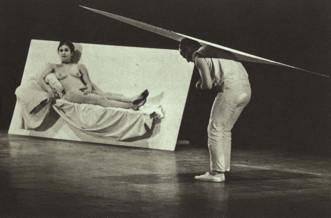 Robert Morris and Carolee Schneemann, "Site" (1963) | 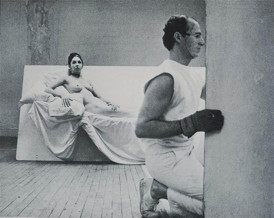 Robert Morris and Carolee Schneemann, "Site" (1963) |
Sources :
http://www.variablemedia.net/f/introduction/case_morri_site_b.html
http://www.mariabuszek.com/kcai/GenresMedia/9-12Images.htm
Evening 4 (September 13, 1964 - Moderna Museet) |
- Öyvind Fahlström, Ur Mellanöl (happening)
 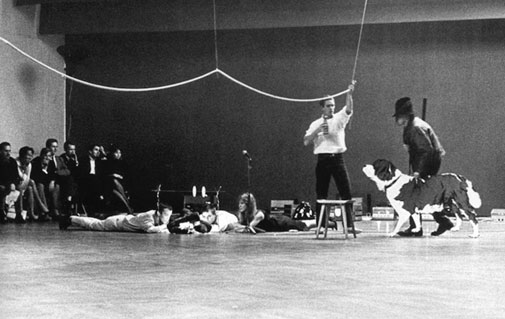 Öyvind Fahlström, "Ur Mellanöl"", Photo : Ljud-Dikt, Moderna Museet |
- Steve Paxton, Robert Rauschenberg, Would Like to Make a Phone Call
- performed by Robert Rauschenberg and Steve Paxton
- Source : http://archive.org/stream/robertr00hopp/robertr00hopp_djvu.txt
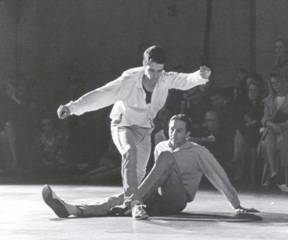 Steve Paxton, Robert Rauschenberg, "Would Like to Make a Phone Call" |
- Robert Rauschenberg, Elgin Tie
- performed by Robert Rauschenberg
- The artist slid down a rope from the museum ceiling and landed in a barrel of water, after which he followed a real cow out of the gallery.
With music by David Tudor : "Fluorescent Sound" (see below) - Rauschenberg choreographed a duet for himself and a large cow. The dance began with the artist lowering himself from a skylight down a rope laden with sundry objects that he manipulated, articles of clothing that he donned, and a sandwich that he ate along the way. The end of the rope dangled into a large barrel of water set on a flatbed hand truck. After submerging himself in the water, Rauschenberg stepped into a pair of oversize boots nailed to the truck, which allowed him to tilt forward at an otherwise impossible angle. At that moment, the cow was led into and then out of the performance area, as the flatbed was hauled offstage.
- Sources :
http://www.modernamuseet.se/en/Stockholm/Exhibitions/2007/Robert-Rauschenberg-Combines/Biography/Robert-Rauschenberg-and-Moderna-Museet/
http://archive.org/stream/robertr00hopp/robertr00hopp_djvu.txt
http://digitalcollections.mypubliclibrary.com/digital/26/16618/1/17.pdf
http://www.sfmoma.org/assets/research_documents/documents/ABIO_92.278/ABIO_92.278_005.pdf
http://www.archipel.uqam.ca/2366/1/M11048.pdf
http://www.acastronovo.com/ClassHtms/ClassDocs/Goldberg01.pdf
 © Stig T. Karlsson |
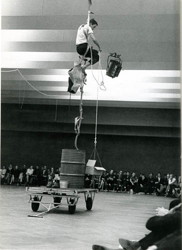 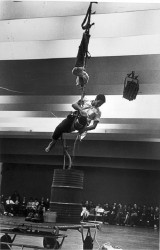 © Hans Malmberg | 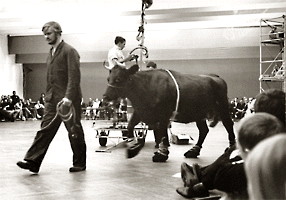 © Stig T. Karlsson |
- Robert Rauschenberg, Shot Put
- performed by Robert Rauschenberg
- In the solo performance, he dances in the darkness with a flashlight attached to his right foot, drawing with light in space, to the accompaniment of an eleven-minute tape recording of excerpts from painter Öyvind Fahlström's "A Lecture on Birds in Sweden" (or "Swedish Bird Calls" / "Faglar i Sverige"), which is a reading of Edgar Allan Poe's "The Raven" using stylized vocalizations.
- Source : http://archive.org/stream/robertr00hopp/robertr00hopp_djvu.txt
http://sv.wikipedia.org/wiki/F%C3%A5glar_i_Sverige_%28radiokomposition%29
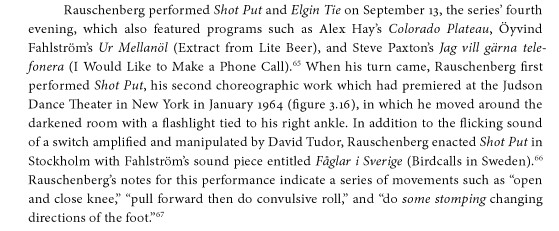 Hiroko Ikegami, "The Great Migrator: Robert Rauschenberg and the Global Rise of American Art", pp. 132-133, Cambridge MA : MIT Press, 2010. |
- Alex Hay, Colorado Plateau (1963)
- performed by Robert Rauschenberg
- Source : http://archive.org/stream/robertr00hopp/robertr00hopp_djvu.txt
- David Tudor, Fluorescent Sound
- "Fluorescent Sound", consists of the sounds that are picked up by microphones attached to fluorescent lights when the lights are turned off and on by Tudor. — Fluorescent Sound was David Tudor’s debut as a composer and was performed at the Modern Museum in connection with Rauschenberg’s performance Elgin Tie, on the 13th of September 1964. The piece was composed while switching on and off the Museum’s existing fluorescent light banks. The so created popping and pinging sounds where then amplified with the help of contact microphones.
- The turning point came during the Cunningham Company’s six-month world tour in 1964, when Tudor made his first appearance as a composer in his own right. Typically, it was an anonymous debut, and only later did Tudor look back and acknowledge that he had crossed the line from performer to composer. (Long before, critics confounded by the indeterminate scores Tudor performed as a pianist were lamenting that the line had already been erased.) Robert Rauschenberg, officially the Cunningham Company’s set and costume designer, had won the Venice Bienniale, and as a result of his new celebrity was invited to stage his own performance event at Stockholm’s Moderna Museet. When he asked Tudor to contribute music to the event, Tudor enlisted the help of several members of the museum’s staff, who spent nearly three days attaching contact microphones to more than two hundred fluorescent light bulbs in two gallery ceilings. At the performance, Tudor amplified the sounds made not by the bulbs but by their switching on and off, as Rauschenberg entered the gallery on the back of a Brahma bull and then immersed himself in a barrel of water. Rauschenberg called the event “Elgin Tie.” Tudor did not name his contribution (he later gave it the functional title "Fluorescent Sound") or even mention it in his letters to Richards during the tour. He still thought of himself not as a composer but a performer. — (John Holzaepfel)
Source : http://www.newworldrecords.org/uploads/fileAdomv.pdf - He said of the Stockholm project that he was happy doing something entirely of his own, and acknowledged it as perhaps his “first real composition.” — (Gordon Mumma, Notes on "Rainforest")
- The original score called for over 200 fluorescent lights controlled by about 75 switches. Tudor performed the switch box, turning on banks of lights until the popping and pinging stopped then turning them off again. With the huge number of switches at his disposal this turned out to be a full-time ocupation. A time-score was created which indicated when these switches were to be turned on and off. Here is David's description of the whole thing:
"It was done at the Festival for Modern Dance and Robert Rauschenberg who was doing a dance collaboration with Steve Paxton asked if I would do the music. I said yes and I walked around the museum and thought 'what am I going to do?' I noticed that there were - it must have been- a thousand fluorescent light bulbs. One day I was in the room when someone was turning on the fluorescent lights and they didn't know which to turn on and all of a sudden there was the most beautiful music. I thought, ok, I put some contact microphones up there from the bulbs to see if the sound can be made really audible. In these days the museum had only two large rooms. The room where the sound was beautiful was actually the foyer but the room I has to work in was the larger gallery and when I tried it there, it worked OK but less beautifully than in the other room. I think there were more light bulbs on the same switch in the large room which seemed to make a difference. So then I had to get up on a large ladder and place the contact microphones which actually took nearly three days. Fortunately I had help to do it because there were, I believe, 75 switches with three light bulbs on each switch. It was a big job. It worked very beautifully. The only problem was that Bob Rauschenberg was to come in from the side entrance of the museum riding a Brahma cow, which he did and they asked me to stop the music. (laughter) That was my first composition." — (An Interview with David Tudor by Teddy Hultberg in Dusseldorf, May 17-18, 1988) - Sources :
http://davidtudor.org/About/fsound.html
http://davidtudor.org/Articles/hultberg.html
http://www.jaimeoliver.pe/courses/ci/pdf/driscoll-rogalsky-rainforest.pdf
http://getty.art.museum/research/exhibitions_events/events/david_tudor_symposium/pdf/driscollrogalsky.pdf
http://www.getty.edu/research/exhibitions_events/events/david_tudor_symposium/pdf/miller.pdf
http://faculty.ucr.edu/~ewkotz/texts/Kotz-2009-Dia-Neuhaus-proof.pdf
http://www.dotoday.se/en/malmo/moderna-museet-malmo/one/14456655-a
 Source : http://davidtudor.org/Graphics/MMprog2.jpg |
Evening 5 (September 14, 1964 — Moderna Museet) |
- Merce Cunningham and his dance company : Museum Event # 3
- John Cage — Variations IV
- Source : http://cagecomp.home.xs4all.nl/1912-1971.htm
- David Tudor — Fluorescent Sound — ??
- Öyvind Fahlström — Fåglar i Sverige - ??
Audio :(Edit)
La Monte Young, "Two Sounds"
→ [More Info on Two Sounds]
John Cage, "Electronic Music for Piano" (1964)
by Ciro Longobardi, piano - Agostino Di Scipio, computer and live electronics.
Video : (Edit)
Robert Rauschenberg, Interview, In "Painters Painting: The New York Art Scene 1940-1970", a 1972 documentary by Emile de Antonio
View full film : https://www.youtube.com/watch?v=pRG-QFeYg8I
Robert Morris & Stan VanDerBeek, "Site" (1964)
with William S. Burroughs's voice reading "Nova Express: This, gentlemen, is a death dwarf..." (1965) excerpts. Borrowed from Aspen Number 11.
Sources, Urls :(Edit)
- http://www.diva-portal.org/smash/get/diva2:388055/FULLTEXT02 — [Retrieved on 7 November 2013]
- http://uu.diva-portal.org/smash/get/diva2:388053/FULLTEXT02 — [Retrieved on 7 November 2013]
Powered by LionWiki 3.2.5 — Thanks to Adam Zivner — Any material is under copyleft © with in-line & in-text attributions — Hosted by nujus.net NYC
